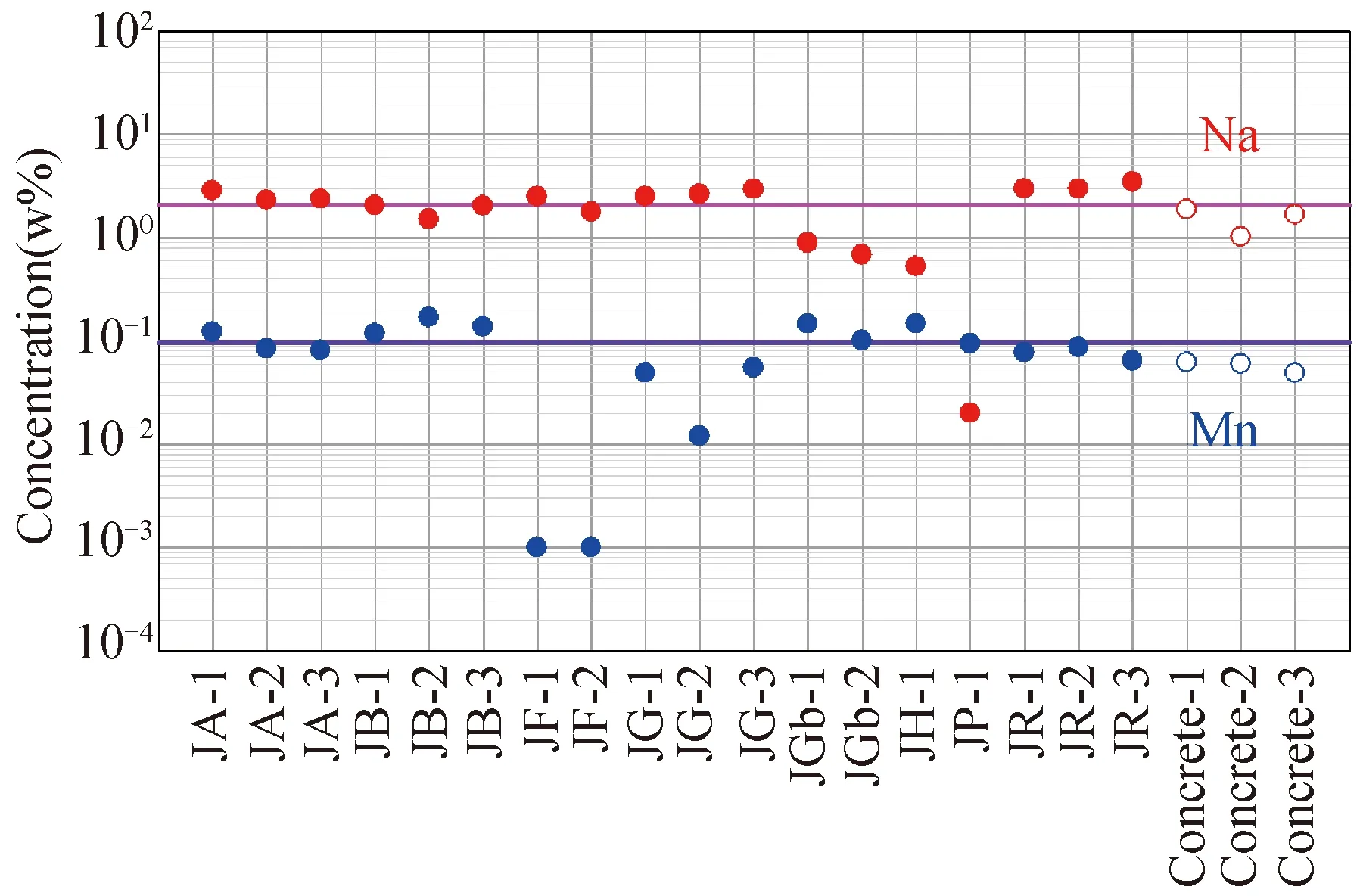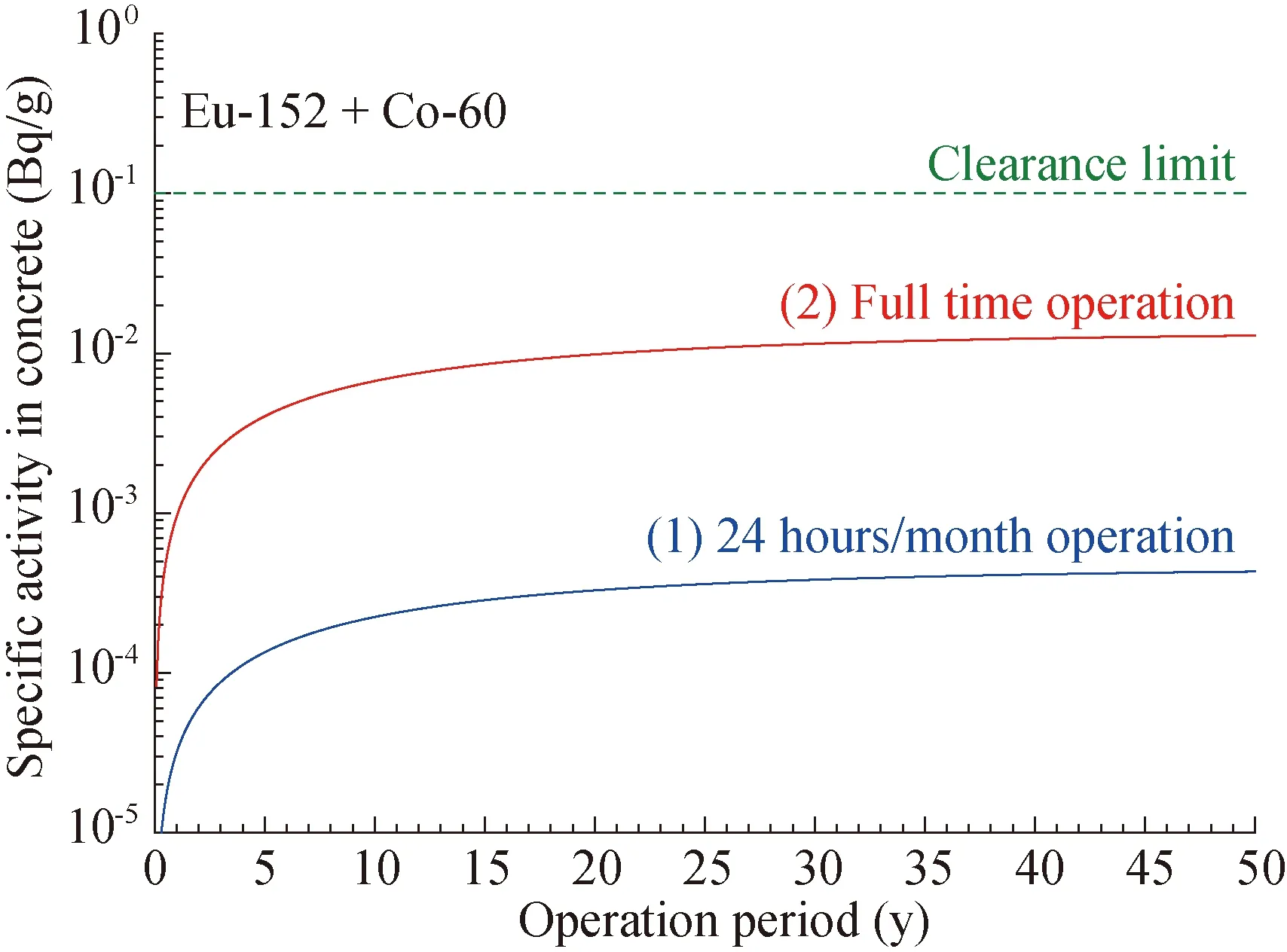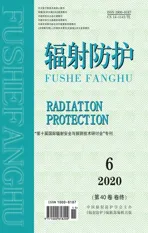Nondestructive high-sensitivity measurement method for activation estimation in accelerator room concrete
2021-01-28HiroshiMatsumuraGoYoshidaAkihiroToyodaKazuyoshiMasumotoHajimeNakamuraTaichiMiuraKoichiNishikawaKotaroBesshoKimikazuSasaTetsuakiMoriguchiFumiyoshiNobuharaYokoNagashima
Hiroshi Matsumura,Go Yoshida,Akihiro Toyoda,Kazuyoshi Masumoto,Hajime Nakamura,Taichi Miura,Koichi Nishikawa,Kotaro Bessho,Kimikazu Sasa,Tetsuaki Moriguchi,Fumiyoshi Nobuhara,Yoko Nagashima
(1.High Energy Accelerator Research Organization (KEK),Oho 1-1,Tsukuba Ibaraki 305-0801,Japan;2.University of Tsukuba,1-1-1 Tennodai,Tsukuba,Ibaraki 305-8577,Japan;3.Tokyo Nuclear Services Co.,Ltd.,1-3-5.Taito,Taito-ku,Tokyo 110-0016,Japan)
Abstract:This study established a method for easily and quickly estimating the specific activity produced in the concrete walls and floors of accelerator rooms during long-term operation of accelerator,for advanced zoning of activated/non-activated areas in planning the decommissioning of an accelerator.We propose a new,highly sensitive method for nondestructively estimating the specific activity in concrete that can be applied to activation zoning.In this method,instead of direct determination of the specific activities of important long-half-life radionuclides for decommissioning,such as 152Eu and 60Co,we determine the specific activities of short-half-life radionuclides,24Na and 56Mn,in situ to obtain neutron flux.The obtained neutron flux and accelerator operation history yield the specific activities of 152Eu and 60Co for the advance zoning of activated/non-activated concrete.This method is a powerful long-term prediction tool for concrete activation.
Key words:accelerator;activation;concrete;specific activity;decommissioning
1 Introduction
This study established a method for easily and quickly estimating the specific activity produced in the concrete walls and floors of accelerator rooms during long-term accelerator operation.The proposed method allows for the advanced zoning of activated/non-activated concrete in facilities operating accelerators,which is very important for planning the decommissioning of an accelerator.This task is inherently challenging because the volume of concrete in accelerator rooms is large.
In a previous study at a cyclotron facility,we found that two long-half-life radionuclides,152Eu and60Co,should be considered during the decommissioning of concrete[1].In conventional methods,these radionuclides are determined by γ-ray spectrometry after concrete core sampling.However,performing destructive sampling of the concrete,which comprises the structure of the room at many locations,is difficult for operating accelerators.Long in situ measurements of152Eu and60Co γ-rays also present logistical challenges for operating accelerators.
We proposed a new,highly sensitive method for nondestructively estimating specific activity in concrete that can be applied to activation zoning.In this method,instead of direct determination of the152Eu and60Co specific activities,we determine the specific activities of short-half-life radionuclides,24Na (15 h) and56Mn (2.6 h),in situ.In concrete,152Eu,60Co,24Na,and56Mn are produced by the thermal neutron capture reactions of151Eu,59Co,23Na,and55Mn,respectively.Because the concentrations of Eu,Co,Na,and Mn in concrete are roughly consistent for all concrete sources,the production rates of24Na and56Mn are correlated with those of152Eu and60Co.As a result,the specific activities of152Eu and60Co can be estimated from the specific activities of24Na and56Mn produced in concrete.
2 Activity measurement of 24Na and 56Mn
2.1 Intentional beam loss operation
This experiment was performed using the proton beam of the 6 MV Pelletron tandem accelerator at the University of Tsukuba Tandem Accelerator Complex (UTTAC)[2]in Japan.Figure 1 shows the beamline of the accelerator.Protons were accelerated to an energy of 12 MeV during the experiment.The accelerated protons were transported into a target for intentional beam loss installed in the experimental room.The average current of the proton beam was 1.052 μA,which was measured using a Faraday cup at the target.The duration of the beam operation was 2.0 h.
A 1 mm-thick stainless steel (SUS304) plate was used as the target.The target was installed into a chamber made of stainless steel on the beamline at a height of 177.5 cm from the floor surface.The proton beam was completely stopped in the target.

Fig.1 Floor measurement points concerned with the beam loss points on the beam transport line.The height of the beamline is 177.5 cm from the floor level.The distance to the floor measurement point from the beam axis is 120 cm
2.2 In situ measurement of γ rays from concrete floor
After 0.73 h from the end of accelerator operation for the intentional beam loss experiment,for in situ measurements,a portable Ge detector (Canberra Inc.,GR2018) was kept in contact with the surface of the concrete floor.The measurement location was 120 cm from the beam axis and side of the target (see “the floor measurement point A” in Figure 1).To limit the detection to close range from the Ge detector,the detector was shielded from ambient γ rays by a cylindrical Pb shield (thickness:6.5 cm;length:22.0 cm;and hole diameter:9.0 cm).The measurement of γ rays was performed for 1 003 s.Figure 2 shows a γ-ray spectrum that was obtained using the Ge detector on the concrete floor.Photo-peaks can be clearly observed from24Na and56Mn.
2.3 Specific activities of 24Na and 56Mn produced in the concrete floor
The γ-ray energies used for the analysis were 1369 keV for24Na and 847 keV for56Mn.The nuclear data were taken from[3].The used portable Ge detector was characterized for ISOCS by Canberra Inc.[4-5].The detection efficiencies of the Ge detector for γ rays from the concrete floor were obtained by using ISOCS,assuming that the γ-ray source was distributed uniformly in the concrete floor.The details of the efficiency calculation were the same as the method described in previous work[1].The detection efficiencies for 1 369 keV γ-ray of24Na and 847 keV γ-ray of54Mn were determined to be 13.6 and 15.0 (counts/s)/(Bq/g),respectively.The specific activities produced in the concrete floor at the end of accelerator operation were determined to be (0.031 ± 0.002) Bq/g for24Na and (0.074 ± 0.005) Bq/g for56Mn.

Fig.2 Gamma-ray spectrum obtained using the Ge detector on the concrete floor near the target 0.73 h after the end of accelerator operation for the intentional beam loss experiment
3 Thermal neutron flux in concrete
3.1 Typical concentrations of Na and Mn in concrete
In this method,the concentrations of Na and Mn in concrete are necessary for obtaining the flux of thermal neutrons that passed through the objective concrete floor.Typical concentrations of Na and Mn in concrete were determined from the Na and Mn concentration in the Geological Survey of Japan (GSJ) rock reference samples and three real accelerator concrete shields.
Figure 3 shows the concentrations of Na and Mn contained in the GSJ rock reference samples and the accelerator concrete shields;despite some exceptions,these concentrations are generally consistent.The concentrations in the GSJ rock reference samples agree well with those in the concrete shields.The average concentrations of 2.1 wt% for Na and 0.095 wt% for Mn were determined as the typical concentrations.

Concrete-1:a concrete shield for a cyclotron at the Medical and Pharmacological Research Center Foundation in Japan,Concrete-2:a concrete shield for the 500-MeV proton accelerator,KENS at KEK in Japan,and Concrete-3:a concrete shield for the 12-GeV proton accelerator,EP2 at KEK in Japan.The pink line represents the average value for Na except for JP-1.The purple line represents the average value for Mn except for JF-1,JF-2,and JG-2.Fig.3 Concentrations of Na and Mn contained in the GSJ rock reference samples and accelerator concrete shields
3.2 Measured values of thermal neutron flux
The thermal neutron flux that passed through the concrete floor was estimated from the specific activities of24Na and56Mn in the concrete floor and the typical Na and Mn concentrations in concrete,determined in the previous sections.For the calculation of thermal neutron flux,the cross sections of thermal neutron capture reactions for Na and Mn were 0.53 b and 13.3 b,respectively[3].As a result,thermal neutron fluxes of 1.2×103and 1.3×103neutrons/cm2/s were obtained from24Na and56Mn,respectively.The results from24Na and56Mn agreed very well,even though the typical concentrations of Na and Mn in concrete were used for calculation.It was found that the thermal neutron flux passed through the concrete floor was approximately 1×103neutrons/cm2/s for full loss of 1 μA 12 MeV proton beam at stainless steel.
3.3 Monte Carlo simulation
The flux distribution of the thermal neutrons generated by 12 MeV proton bombardment at 1.052 μA of beam current with the stainless-steel target was calculated using the PHITS code (version 2.88,nuclear cross section library:TENDL-2014 and JENDL-4.0)[6].The input calculation geometry around the stainless-steel target was the same as the beamline at UTTAC.
Figure 4 shows the vertical distribution of the thermal neutron flux near the stainless-steel target across the beam axis.Under the floor surface,the thermal neutron flux shows a consequent increase caused by the moderation of epithermal neutrons inside the concrete.

Fig.4 Vertical distribution of the thermal neutron flux near the stainless-steel target across the beam axis
The thermal neutron flux is roughly constant from the floor surface to a depth of 20 cm,where γ rays from24Na and56Mn can penetrate concrete.A similar depth profile was observed in specific activity in the concrete walls of a 12 MeV proton cyclotron facility[1].Thus,the uniform distribution assumption of specific activity for detector efficiency calculation described in Section 2.3 is reasonable.
3.4 Comparison with the TLD measurement
On the surface of the concrete floor,the thermal neutron flux was also measured with a thermo-luminescent dosimeter (TLD) putting on the concrete floor at the same location of the Ge detector measurement[7].The measured value of the thermal neutron flux was (8.3±2.1)×102neutrons/cm2/s.The result from the TLD was slightly lower than the results from24Na and56Mn because of the moderation of epithermal neutrons inside the concrete,yet the values were approximately comparable.In fact,the24Na and56Mn method,for the direct measurement of the concrete body can estimate the thermal neutron flux more accurately than the surface measurement by TLD.
4 Prediction of 152Eu and 60Co specific activity for long-term operation
In a previous study,we found that two long-half-life radionuclides,152Eu and60Co,should be considered during the decommissioning of concrete[1].The growth curve of the specific activities of152Eu and60Co in the concrete can be predicted from the thermal neutron flux estimated from24Na and56Mn.The concentrations needed for this calculation were those of Eu and Co,whose average values were taken from[8]as 0.7 ppm and 8 ppm,respectively.

(1) 24 hours/month and (2) full time operations,at 1.052 μA of 12-MeV-proton beam currentFig.5 Predicted growth curves of the specific activity (152Eu + 60Co) in the concrete near 100% beam loss point with the stainless steel for the duration of accelerator operation.It was assumed that beam operation was performed in two conditions
Figure 5 shows the predicted growth curves of the specific activity (152Eu +60Co) in the concrete near the 100% beam loss point with the stainless-steel target for accelerator operation over a long time period.The specific activity was predicted for two operating conditions;(1) 24 hours/month operation and (2) full time operation,at 1.052 μA of 12 MeV-proton beam current.
In UTTAC,case (1) is the typical operation schedule.The predicted specific activity for case (1) after 30 years of operation (i.e.,the time of general accelerator usage,which is near activity saturation) is estimated to be negligible (lower than 1/200) compared with the 0.1 Bq/g Japanese clearance limit.In case (2),although not a likely operating condition,the specific activity after 30 years of operation was also predicted to be much lower than the clearance limit.Thus,the entirety of the concrete walls and floor can be discarded as non-radioactive material at decommissioning.
5 Test measurement near the steady beam loss point
There are some high and steady beam loss points on the beam transport line at UTTAC.Figure 1 shows one of the beam loss points on the beam transport line.Floor measurements of24Na near the beam loss point were performed at “the floor measurement point B” for two different experimental operations:(1) 12 MeV protons at 0.020 μA over 16 h and (2) 12 MeV protons at 1.028 μA over 4.0 h.Here,beam loss rates were measured to be 5.8% for Operation (1) and 0.11% for Operation (2).The beam loss rates were determined by comparing the activity production rate of52Mn in the stainless steel (SUS304) beam duct with that in the stainless-steel target used for the intentional beam loss experiment.
In both the operations,γ rays from24Na in the concrete floor could be detected beside the beam loss point.Thermal neutron fluxes obtained from the24Na specific activities were measured to be 7.6 neutrons/cm2/s for Operation (1) and 54 neutrons/cm2/s for Operation (2).When operating for 24 hours/month using Operation (2),which has a higher thermal neutron flux,is performed continuously long term,the thermal neutron flux would yield a specific activity of152Eu +60Co of only 1.7×10-5Bq/g after 30 years of operation.
This method predicts the specific activity produced in the concrete to be at levels much lower than the 0.1 Bq/g Japanese clearance limit.This method can thus be applied as a high sensitivity measurement method for advanced zoning of activated/non-activated areas at other accelerator facilities.
6 Conclusion
The proposed method,which determines24Na and56Mn specific activities produced in concrete in situ,has four merits:(1) its measurements are nondestructive,(2) its measurements are fast because of the high sensitivity of γ-ray detection,(3) its measurements for the concrete body estimate the thermal neutron flux more accurately than the surface measurement on concrete using TLD etc.,and (4) it has an easy-to-follow accelerator operation status as a consequence of the short half-lives of24Na and56Mn.The specific activities of24Na and56Mn and the accelerator operation history yield the specific activities of152Eu and60Co for the advance zoning of activated/non-activated concrete.This method is a powerful long-term prediction tool for concrete activation.
Acknowledgements:This work was supported by Radiation Safety Research Promotion Fund.This work was performed as one of the Priority research areas for FY2017 and FY2018,Clearance of materials from the decommissioning of accelerator facilities,in the Radiation Safety Research Program.The authors thank Drs.Hidetsugu Tsuchida (Kyoto Univ.),Yoshitomo Uwamino (RIKEN),Koji Watabe (Tohoku University),and Minoru Ohkoshi (Japan Radioisotope Association) for their important advice on this study.
